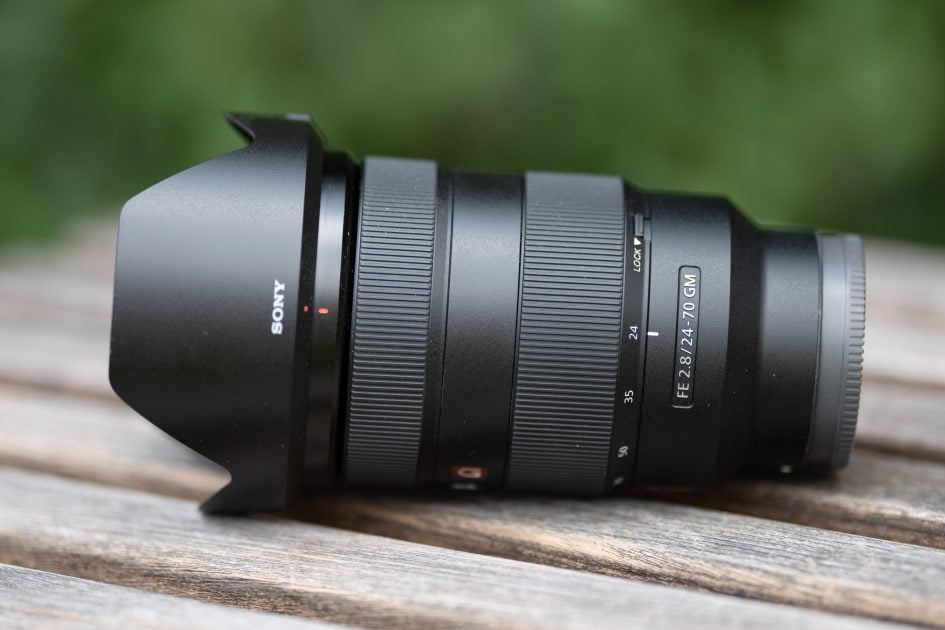Sony FE 24-70mm f2.8 GM review
-
-
Written by Thomas
Verdict
The Sony FE 24-70mm f2.8 was one of the first G-Master, or GM, lenses, launched in 2016 and boldly claiming the company’s best optical quality to date. As a popular general-purpose range for events and weddings with a bright aperture for shallow depth-of-field effects, it’s an essential lens for working pros and enthusiasts alike. Judged on its own merits the Sony FE 24-70mm f2.8 GM is a well-rounded package which produces sharp to very sharp and contrasty images with only little color aberrations and a pretty nice Bokeh. Its features include a zoom-lock, lockable lens-hood, well padded lens case plus strap, and a function button which can be used for focus-lock or other assignable functions. Its distortions are well corrected (through lens profile) and it has very usable close-up performance down to a magnification of 1:4 once you stop down to f5.6. Plus the zoom keeps focus throughout its range – unless you zoom out to 24mm.
What’s not to like? The lens becomes gradually softer at the longer end with 70mm being its weakest focal length. And there’s also some auto-focus variation that can lead to less than optimal sharpness too. Arguably its biggest issue though is the price which, while cheaper than the equivalent mirrorless models from Canon and Nikon, remains considerably more expensive than alternatives from third parties. Most notably Tamron and Sigma now offer f2.8 standard zooms in the native e-mount at half the price of the Sony or lower still.
Let’s have a closer look at how the Sony compares to other alternatives.
Above: Sony FE 24-70mm f2.8 GM
Compared to Tamron 28-75mm f2.8 Di III
The Tamron 28-75mm f2.8 Di III RXD is a valuable addition to the full-frame E-Mount market, that’s wisely pitched between Sony’s entry-level FE 28-70mm f3.5-5.6 kit zoom and the high-end FE 24-70mm f2.8 G Master. The Tamron is stunningly sharp in the APS-C image-circle across the zoom range although it becomes softer than the Sony in the full-frame corners. And its close-up performance is almost as good as from the Sony. It’s much smaller and lighter and also has a much lower price than the Sony too which makes the Tamron a viable option for those who can only dream of f2.8 zooms and were otherwise heading to the budget kit lens. And the Sony produces the softer Bokeh and covers a wider angle of view at 24mm than the Tamron which starts at 28mm. This may be the decisive factor: If you want wide the Sony (or Sigma) covers 84 degrees at the short end while the Tamron covers only 75 degrees. This might sway your vote toward the Sony – unless you also consider getting the Tamron 17-28mm f2.8 Di III RXD which nicely covers the very wide angles.
For more details see my Tamron 28-75mm f2.8 Di III review where it got a Recommended.
Compared to Sigma 24-70mm f2.8 DG DN Art
The Sigma 24-70mm f2.8 DG DN Art is a viable alternative to Sony’s FE 24-70mm f2.8 G Master offering some of the same features as the Sony including a zoom-lock switch and a focus-lock button. Plus the unique feature that Sigma’s service can change the mount of the lens between Sony’s E-mount and L-mount (at a cost). Although the lens comes at a much lower price compared to the Sony Sigma has designed it well: The lens is sharp within the APS-C image-circle, has no longitudinal color aberrations, shows little veiling glare in contra-light situations, and has a reliable autofocus. Unfortunately the Sigma becomes gradually softer at closer focusing distances right down to pretty mushy results at minimum object distance. This may make the lens miss out on our top award, but it still clearly earns a recommendation.
For more details see my Sigma 24-70mm f2.8 DG DN Art review.
Sony FE 24-70mm f2.8 GM final verdict
A 24-70mm f2.8 zoom lens is the workhorse for many professional photographers and aspiring amateurs alike. And no camera system is competitive without such a lens delivering very good optical quality. In 2016 the FE 24-70mm f2.8 G Master was Sony’s showcase for a large aperture standard zoom lens and helped establish the excellent reputation for its G Master series with sharp to very sharp and contrasty images, low color aberrations and a pretty nice Bokeh. Optical performance is complemented by a high-end feature set including a zoom-lock, lockable lens-hood, well padded lens case plus strap, and a focus-lock button. But the competition has not been sitting still: Tamron and Sigma now offer more recent standard zoom lenses that come close or even surpass the optical performance of the Sony especially at the long end – while crucially costing much less. In the light of full-frame sensors now reaching and surpassing 60MP it could be time for Sony to update the optical formula of their 24-70mm zoom lens to stay at the top of the game. But their current FE 24-70mm f2.8 G Master still clearly earns a recommendation.
Good points:
- Constant f2.8 focal ratio.
- Sharp and contrasty in the APS-C image circle.
- Low longitudinal color aberrations.
- Good black levels in contra-light situations.
- Parfocal zoom (except for 24mm).
Bad points:
- Visibly softer at 70mm.
- Auto-focus performance may lead to less than optimal sharpness.






